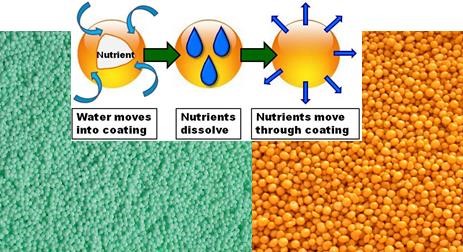
Fig. 1. Example of a coated fertilizer (left) and fertilizer coated with a urease and nitrification inhibitor, right. Coated fertilizer illustration courtesy of International Plant Nutrition Institute (IPNI): http://www.ipni.net/
As fertilizers get more expensive and the need to protect environmentally sensitive areas increases, farmers are looking for more efficient nitrogen (N) fertilizers. The Association of American Plant Food Control Officials (AAPFCO) has defined enhanced efficiency fertilizers (EEF) as “fertilizer products with characteristics that allow increased plant uptake and reduce the potential of nutrient losses to the environment (gaseous losses, leaching, or runoff) when compared to an appropriate reference product.” Reference products are water-soluble. Nitrogen examples include mineral ammonium nitrate, ammonium, sulfate, urea, etc. In regards to N, there are several types of EEFs, including urease and nitrification inhibitors (products that typically coat urea prill), sulfur and polycoated N (coated urea prill), and uncoated, slowly available N fertilizer, such as composts, biosolids, manures, and litters.
Materials garnering attention more recently are the urease and nitrification inhibitor coated urea and polycoated urea (Fig. 1). Urea fertilizer will rapidly convert to ammonium (and ammonia if the surrounding pH is high). This process is controlled by urease enzyme, which is readily available in our soils. Some EEFs work through the use of a urease inhibiting coating to slow the conversion from urea to ammonium or ammonia. This is important because the next biologically mediated step (nitrification) rapidly converts ammonium to nitrate. It is the nitrate form that most readily leaches from our soils and is often a contributor to algal blooms and therefore, degraded water quality. Coatings that limit the conversion of urea to ammonium and/or conversion of ammonium to nitrate, provide plant-available N to the crop more slowly, thereby increasing the chance for uptake and less environmental loss. Polycoated urea is basically an organic polymer coating that limits (but does not eliminate) moisture to the prill (Fig. 1). The prill dissolves more slowly but heat and water can speed up the process, albeit, at a slower rate than without the coating.
Many of the EEFs provide the greatest protection from excessive nitrate leaching losses during warm, wet growing conditions. Uncoated urea fertilizer is also notorious for gaseous N (ammonia) losses following application. The aforementioned EEFs may also help reduce N gaseous losses. There are many products on the market that make claims of improving yields, reducing N losses, etc. However, claiming a product works and it actually working as prescribed are not always the same thing. Additionally, viable EEF N products function like an insurance policy. Sometimes conditions are such that N leaching and gaseous losses are minimal and uncoated fertilizer performs well, while at other times you may lose much of your uncoated fertilizer, particularly from leaching below the root zone after a heavy rain.
It is in the interest of the consumer to become educated on which products have good track records (extension or state specialists can sometimes help) and determine the cost-benefit of using a product (EEFs typically have a premium) in regard to your needs. The North Florida Research and Education Center Beef Unit, Marianna, FL, is hosting A Beef/ Forage Field Day, on October 3rd. One of the tour stops will briefly discuss N fertilizer sources and rates for use in pastures. We look forward to you joining us!
- 2024 Perennial Peanut Field Day – June 6 - April 5, 2024
- Nitrogen Fertilization of Perennial Summer Grasses - June 30, 2023
- Utilizing Winter Forage Blends for Insurance Against Climate Chaos - January 13, 2023
